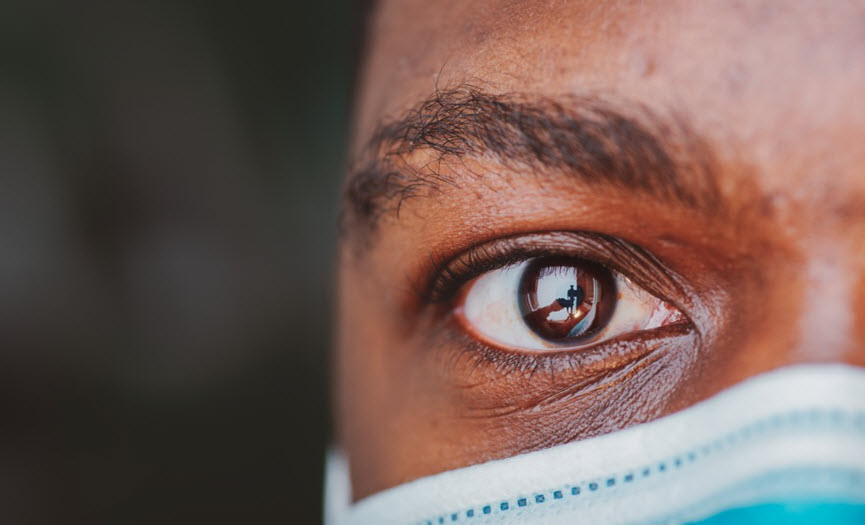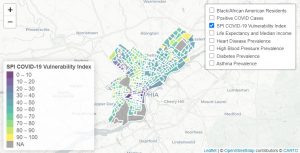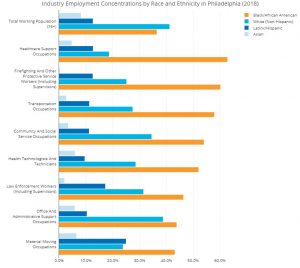
The Impact of COVID-19 on Philly’s African American Community
A recent report from the U.S. Centers for Disease Control and Prevention (CDC) has shown that the COVID-19 virus is affecting Black Americans more than any other racial group. Across various states and cities (as well as in Philadelphia), the disproportionate hospitalization and death of Black patients demonstrates how health inequalities both persist and are exacerbated during times of crisis. In this Leading Indicator, we examine the social determinants of health that disproportionately position Black Philadelphians on the frontline of this pandemic.
Key Takeaways
- Poverty, and its high correlation with race and ethnicity, is a key determinant of adverse health since low-income populations have higher rates of unemployment and little to no health insurance coverage.
- With a higher predisposition to chronic diseases resulting from decades of systemic poverty and racism, Black Philadelphians face a higher risk of developing severe cases of the COVID-19 virus.
- Black Philadelphia workers are highly concentrated in healthcare support, community social service, transportation and delivery, and public safety occupations, placing them disproportionately on the frontlines of the pandemic.
- A colorblind approach to treating this pandemic will continue a long history of health inequities in Philadelphia that will only make future health crises more devastating.
Poverty’s Links to Adverse Health
Since the early 1990s Philadelphia has been a majority-minority city where the Black/African American population has been the largest racial group [1]. Despite undeniable progress in many areas, Black Philadelphians continue to struggle against a legacy of inequities like systemic residential, occupational, and financial redlining that has led to declines in effective household wealth, constricted employment, and hindered business development opportunities which have subsequently kept many Black residents living in poverty. In fact, as of 2018, roughly a third of Philadelphia’s Black population was living below the federal poverty level, versus only 14 percent of the Non-Hispanic White population [2].
Poverty, and its correlation with race and ethnicity, is a key determinant of adverse health. Individuals experiencing poverty have higher rates of unemployment and are less likely to have any form of adequate health insurance coverage – therefore their health conditions often go untreated. In the U.S, poorer individuals also tend to live in neighborhoods with subpar housing, greater exposure to pollution and other toxins, and limited access to healthy food options – which only exacerbates chronic health conditions [3].
Philadelphia’s Black population is deeply affected by the chronic conditions brought on by systemic poverty, structural inequality, and persistent bias. According to Philadelphia’s most recent “Health of the City” report, non-Hispanic Black populations consistently see some of the poorest health outcomes in the city relative to other racial and ethnic groups with high rates of hypertension, heart disease, diabetes, childhood asthma, and obesity. In fact, Black Philadelphians have the highest mortality rates of any other racial or ethnic group, with non-Hispanic Black men living on average three and a half years less than the city’s average male life expectancy and Non-Hispanic Black youth being three times as likely to die before the age of 20 than Non-Hispanic White youth [4,5].
The chronic health conditions prevalent within Philadelphia’s Black communities place them at greater risk for contracting more severe cases of the COVID-19 virus. The CDC recently reported that the virus is disproportionately affecting older individuals and those with underlying medical conditions—like heart conditions, lung disease, obesity, and diabetes—resulting in more aggressive cases that are more likely to lead to hospitalization and death [6]. Because of the history of chronic conditions brought on by systemic poverty, Philadelphia’s Black population shows the greatest risk of contracting severe COVID cases among the city’s racial and ethnic populations. Figure 1 illustrates this risk by showing the overlapping spatial correlation between the concentration of Black/African American neighborhoods and pertinent health indicators related to the COVID-19 virus (curated by the Social Progress Imperative). It shows that this pandemic is exacerbating existing health inequalities tied to poverty, prejudice, race, and ethnicity.
NOTE: Data for these maps were obtained from U.S. Census’ 2014-2018 American Community Survey Five-Year Estimates, the National Center of Health Statistics’ U.S. Small-Area Life Expectancy Estimates Project’s 2010-2015 estimates, and the Social Progress Imperative’s COVID-19 Vulnerability Index.
Black Workers on the Frontlines
In addition to the underlying chronic conditions that put Black Philadelphians at a higher risk for developing severe cases of the COVID-19 virus, many African Americans work within “essential” or “life-sustaining” occupations that prevent them from social distancing. In fact, many of the city’s Black workers face greater risk of exposure as they perform their daily work.
Figure 2 uses U.S. Census estimates to highlight eight occupational groupings with higher than average concentrations of Black/African American workers. While Black residents in Philadelphia constitute 36.4 percent of the city’s total salaried workforce, their concentration in healthcare support and community social service occupations far outpaces any other racial or ethnic group. Black Philadelphians represent almost 63 percent of Healthcare Support Occupations, 54 percent of Community and Social Service Occupations, and 52 percent of Health Technologists and Technicians. These categories include nursing assistants, orderlies, medical assistants, medical equipment preparers, lab techs, home health aides, community and public health workers, and social workers – all on the frontlines of the pandemic. In short, Black Philadelphians run a greater risk of infection as they work to mitigate the spread of this virus.
NOTE: Data for this graph were obtained from the U.S. Census’ 2018 American Community Survey One-Year Estimates.
In addition to disproportionate representation in healthcare support occupations, Black Philadelphians are also strongly represented in various transportation, material moving, and protective service occupations. These workers keep supplies and other essential workers moving during the pandemic while also maintaining public safety and order. African Americans comprise 57.9 percent of Transportation Occupations, 43.1 percent of Material Moving Occupations, 60.2 percent in Firefighting and Other Protective Service occupations, 46.4 percent of Law Enforcement Workers – again, all occupations deemed essential, and all on the frontlines of the pandemic.
Pandemics Are Not Colorblind
Public health events like the COVID-19 pandemic tend to expose the cracks within our healthcare, occupational, and housing systems. These cracks often form along lines of race, ethnicity, and income. With a long history of structural racism, every new disease or health crisis disproportionately puts communities of color at greater risk of illness and death. Pandemics are not colorblind, so our solutions and strategies must not be colorblind either.
Black communities in Philadelphia face greater risk in the wake of this pandemic. In addition to the underlying structural conditions that make African Americans more susceptible to developing severe cases of the COVID-19 virus, Blacks also have higher employment levels in essential occupations that pose a greater risk of exposure. Greater prevention resources and funding should be funneled into these communities to build a better healthcare infrastructure that will alleviate both existing and future health burdens. COVID-19 testing in these communities should also outpace other communities within the city, and the barriers to getting tested should be lowered for residents with underlying health conditions. In addition, Philadelphia’s publicly-released COVID-19 data ought to indicate racial and ethnic identifiers for both positive and negative cases to better monitor the spread of the disease among distinct communities. Data reflecting higher incidences in one community would allow officials to more directly target interventions and better allocate resources.
As the single largest racial group in the city, comprising more than one-third of the city’s workforce and disproportionately represented in frontline occupations, Black Philadelphians are playing an outsized role in the city’s response to the pandemic and will play an essential role in the city’s post-pandemic recovery. Implementing a targeted approach to treating this pandemic, with an eye toward ameliorating the underlying social determinants of health in Philadelphia’s African American communities will be the best way to move forward. This will require corralling the local players within Philadelphia’s healthcare ecosystem along with the various branches of government. It will be difficult to break down these silos and promote cross-collaboration, but allowing the pandemic to disproportionately devastate the city’s Black communities will make the post-pandemic recovery far more difficult and costly.
Written by Mike Shields
[This post originally appeared on Economy League on April 15, 2020]
Works Cited
[1] The Philadelphia Research Initiative. 2011. “A City Transformed: The Racial and Ethnic Changes in Philadelphia Over the Last 20 Years.” The PEW Charitable Trusts, June 1. Retrieved from: (https://www.pewtrusts.org/~/media/legacy/uploadedfiles/wwwpewtrustsorg/reports/philadelphia_research_initiative/PhiladelphiaPopulationEthnicChangespdf.pdf).
[2] U.S. Census Bureau. 2019. 2014-2018 American Community Survey 5-Year Estimates, Table B17020B. Retrieved from: (https://data.census.gov/cedsci/table?table=DP05&tid=ACSDT5Y2018.B17020B&g=0100000US_0500000US42101&lastDisplayedRow=29&vintage=2018&layer=state&cid=DP05_0001E&t=Black%20or%20African%20American%3APoverty&y=2018).
[3] Ray, Rashawn. 2020. “Why are Blacks dying at higher rates from COVID-19?” Brookings, April 9. Retrieved from: (https://www.brookings.edu/blog/fixgov/2020/04/09/why-are-blacks-dying-at-higher-rates-from-covid-19/).
[4] Department of Public Health, City of Philadelphia. 2019. “Health of the City 2019.” Retrieved from: (https://www.phila.gov/documents/health-of-the-city/).
[5] Department of Public Health, City of Philadelphia. 2019. Brotherly Love: Health of Black Men and Boys in Philadelphia. Philadelphia, PA: City of Philadelphia. Retrieved from: (https://www.phila.gov/documents/brotherly-love-health-of-black-men-and-boys-in-philadelphia/).
[6] National Center for Immunization and Respiratory Diseases (NCIRD), Division of Viral Diseases. 2020. “Information for Healthcare Professionals: COVID-19 and Underlying Conditions.” Centers for Disease Control and Prevention, Coronavirus Disease 2019 (COVID-19). Retrieved from: (https://www.cdc.gov/coronavirus/2019-ncov/hcp/underlying-conditions.html).



